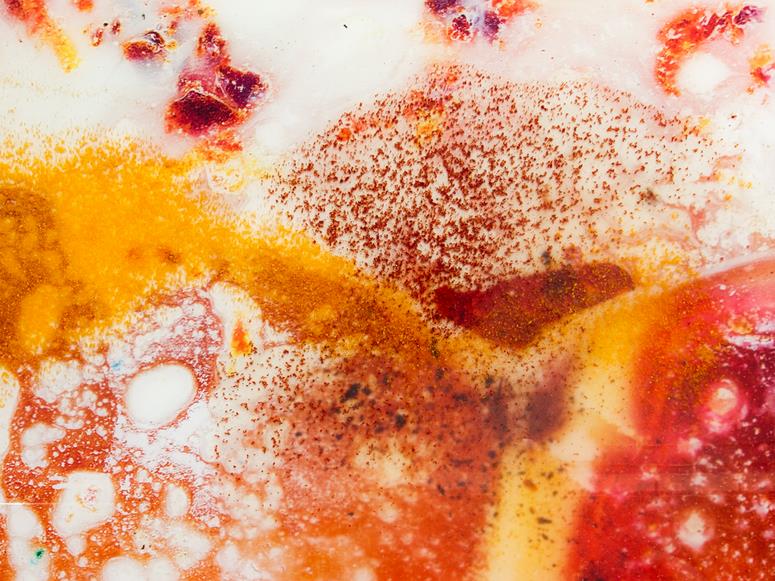Bento #1 2017; digital print and pigmented resin in wooden panel; courtesy the artist and Sullivan + Strumpf
When viewing the sumptuous works by Indonesian artist Arin Dwihartanto Sunaryo for the first time it feels like a beautiful wave of colour and mystery has landed in full bloom on the gallery walls. It leaves you with the burning question: How has he managed such polished beauty?
The artist has used cooking ingredients mixed with resin, but Sunaryo insists that the ingredients, such as corn, chilli and milk are not important. He told me in a conversation that he was more concerned with the process rather than the ingredients per se.
But you can’t escape their culinary pull – literally “eye candy” as coffee, sugar and chocolate seemingly float on the canvas in free-fall, but in reality have been squeegied and mixed into the resin.
Sunaryo began to use resin by accident. He explained in our conversation: ‘I just wanted to explore painting, [which] is becoming more open. I’m learning something new; I’m doing a residency in a chemicals laboratory.’
He speaks in the present tense but he means in the past before his resin-based work started, and spent time in a Jakarta-based resin and pigment industrial plant to learn how to maintain the humidity, the temperature and measure constantly the quality of the resin. I find myself admiring & respecting his wish for perfection.
Sunaryo, similarly, had an obsession to become a chef when at high student. He mentioned: ‘Organic resin comes from trees – amber resin preserves tree parts.’ Sunaryo is interested in the play of words and a duality of meaning. He’s interested in the relationship between things and how they are mysteriously connected. He speaks of ‘preserving ideas, preserving the moment, preserving paintings and photography, and we also preserve food.’
Just thinking about the titles of his work makes interesting room for thought, and the title of this show After Taste – the spectacular surface manages to satisfy in one a desire for sumptuousness in a grand scale, but softly as in a waking dream, and layered with subtleties and nuances. Just like his works, its about allusions, and this exhibition leaves the viewer curious.

Omnivore #2 2017 digital print and pigmented resin in wooden panel; diameter 80 cm (each) ; courtesy the artist and Sullivan + Strumpf
Spending time with this show – which is Sunaryo’s debut exhibition in Australia – I search for something recognisable, but hesitate on conclusions, not sure that I have interpreted these “landscapes” correctly. We are almost “hardwired” to read them as landscapes – Omnivoire 1 & 2 in particular have that quality – digital prints with pigmented resins presented as a rotondo panels.
But then should we allow out imagination to make such associations – after all these works are all free-floating abstract shapes. They appear to be out of focus photographs mixed with torn paper and ingredients. It is this unidentifiable element that beckons and adds to the allure for the viewer, as well as the intensity of the palette.

Long Instant Relationship 2017, pigmented and chromed resin on wooden panel; courtesy the artist and Sullivan + Strumpf
Works that stand out for their vibrancy and sense of joy are Memories Over Calories, and especially the orange work, Long Instance Relationship – which also includes extra hot chili flakes and instant noodles.
The collage-like mix of the diptych, No Room for Dessert (2017), is made of spices and even volcanic ash. In 2010 many villages in Indonesia were covered in volcanic ash when Mount Merapi erupted. Sunaryo decided to incorporate the ash into some works.

No Room For Dessert 2017, pigmented resin on wooden panels; courtesy the artist and Sullivan + Strumpf
Part of the exhibition at Sullivan + Strumpf is a film installation, presented in the round in the upstairs gallery. This seems to show the ingredients without human hand, in free fall as it was.
Another nuance, adding another texture to this exhibition – is the series of strange little sculpture blocks titled, Leftovers. They are Sunaryo’s bid to be sustainable; they are the waste products left over from the magnificent resin “paintings”.
He says that they remind him of geology, ‘when the earth is sliced open’ he explained. At times he will also embed ephemera into these Leftovers, such as photographs of the paintings as a self-referential clue.
This is an impressive exhibition on many levels. The mere fact that Sunaryo’s final works are so heavy that he employs fifteen assistants as he is unable to lift his work without them is just another point that captures one’s imagination and awe.

Leftover #3 2017, pigment and resin; courtesy the artist and Sullivan + Strumpf
Rating 4.5 out of 5
Aron Dwihartanto Sunaryo: After taste
22 July – 12 August.
799 Elizabeth St, Zetland, Sydney





